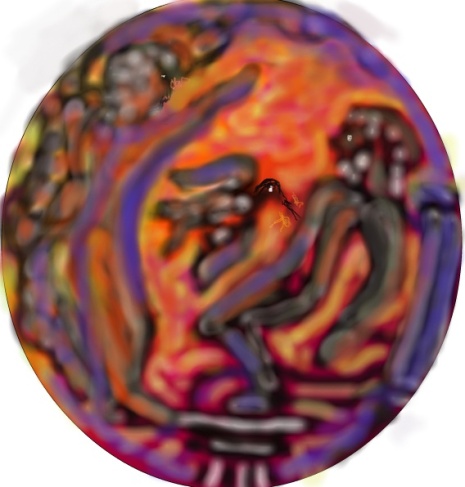
Many Levels have been built into the myth of Prometheus over the centuries (at least up to Frankenstein: or the New Prometheus). It is the most famous example of the two basic sacrifices of L2: pan-community food sharing and the punished trickster.
According to Greek myth, Prometheus tricked the gods into agreeing to accept the least edible part of sacrificed animals, while humans consumed the rest. For this and other transgressions against the gods (notably stealing fire, which apparently was the last straw), Prometheus was condemned to be chained to the Caucasus Mountains, where a vulture (or eagle, or both) devour his entrails. So he is originator of sacrifice and a trickster, but in the exaggerated, heirarchical mode of L3 (competitor/hero) rather than the calmer, more-egalitarian L2.
For the latter, think of Coyote, the trickster among Southwest Amerindian tribes. When he stole fire, he did not do so alone but as the leader of a group including Squirrel and Chipmunk. His punishment was not centuries of having his entrails extracted but having the tip of his tail turned white. Coyote is an L2 trickster, but for that very reason not as exciting as the L3 ones such as Prometheus–who perhaps began at L2 with a different story, revised during the L3 period. (Since L2 flourished in the ancient world long before literacy, we can only guess at what its European L2 myths were. When literacy arrived with L4, scribes wrote down the L3 versions of the myths, the ones available then.)
At L2, one’s tribe, the neighboring plants and animals, spirits of nature, and ghosts of ancestors tend to form a community, where they are to some extent interchangeable, a shaman able to turn into an animal, the animals perhaps reincarnations of people, nature spirits sometimes manifest as animals, etc. Coyote may assume the form of a human, animal, or invisible spirit. Consequently, just as each tribal has a responsibility to share food with the whole human tribe, there is a worldwide custom of sharing as well with some others (e.g., spirits), albeit usually the less desired portion.
The majority of an L2 tribe tend to do what has always been done and treat each other according to custom. There is therefore need for tricksters who innovate and are not restrained by politeness from criticizing or punishing those whose misbehavior strains social harmony. The trickster can do so less upsettingly because he (or less often she) does so humorously. Trickster is a role one or more tribal may adopt, particularly in a religious ceremony, the time when the ordinary order is set aside and a mood is created for the unusual.
The founder of modern hypnotherapy, Milton Erickson would wait to hypnotize until that point in the ultradian rhythm when a client was yawning or otherwise less alert and then Erickson might further enhance the dreamlike mood with humor or a myth-like story. He was looking for access to the Unconscious, so that he could bypass the clients’ habitual, limiting beliefs about themselves, and reprogram them for healthier behavior. That is much what the clownish tricksters did in L2 tribes. And the godlike Trickster figures such as Coyote innovated on a larger scale–or more precisely figured in stories told to entertain and thereby shape and or modify social behavior.
But among other things, these stories taught that breaking social rules had a price. The trickster was typically punished for tricks, though generally not severely. Human nature being what it is, I suspect that even though ceremonial tricksters were supposedly not subject to punishment for their clowning, whoever was the butt of the joke might resent it and find some way to repay it, so the trickster was risking becoming in some sense a self-sacrifice.
And with both pan-community meal sharing and the idea of the trickster, L2 originated (albeit in rather nascent form) the notion of the sacred. According to Byrd Gibbens as quoted by George Carlin in Napalm and Silly Putty:
“Many native traditions held clowns and tricksters as essential to any contact with the sacred. People could not pray until they had laughed, because laughter opens and frees from rigid preconception. Humans had to have tricksters within the most sacred ceremonies for fear that they forget the sacred comes through upset, reversal, surprise. The trickster in most native traditions is essential to creation, to birth.”
In contrast to this, of course, L3 Prometheus was probably not having many yuks on the Caucasus Mountains,







